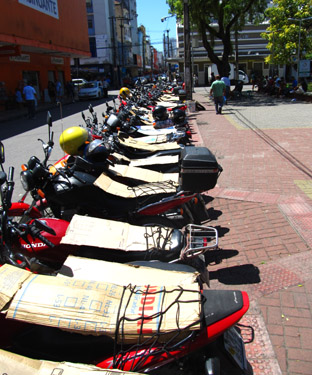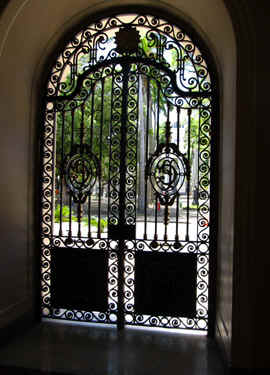Dean &
Ginny's excellent adventures... Main
Adventure Page
Grand
Voyage--2012:
<<
Part 1 <<
Part 2 Part
3 Part 4 >>
Part 5 >>
Part 6 >>
Part
7 >>
Part 8 >>
Part 9 >>
Part 10 >>
Part 11 >>
Part 12 >>
Part 13 >>
Part 14 >>
Part 15 >>
Part 16 >>
Part 17 >>
Part 18 >>
Part 19 >>
Part 20 >>
Part 21 >>
Part 22 >>
Part 23 >>
Part 24 >>
Part 25 >>
|
|

There is no dockage for a cruise ship, so we
anchored out from a small port south of the city and went
ashore via local double-decker ferry boats.
We boarded the ferries on the second level and disembarked from the
first level. Our ferry tied up to a local ferry, which was at the only dock, so
we traipsed through the local boat to get ashore. >>
|
Belem is a city located 60 miles up the Para River in the southern Amazon delta. We arose early to watch as we
cruised up the wide river and were amazed by the tiny fishing boats
plying the rough water in the darkness. The sun rose into the murky
humidity and revealed even smaller fishing boats.

|
|

Even this far up the river, it was low tide, but the mud did not
halt the local commerce.
We boarded buses and rode 45 minutes into Belem, a
city of contrasts.



Electrified fences and concertina wire barriers are common around
nicer houses and even some churches.
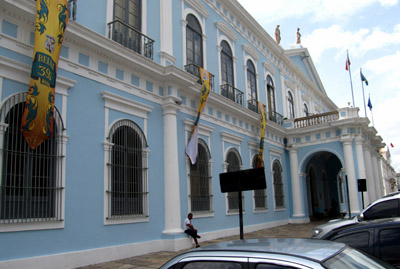
|




These humorous figures strain to hold up a pair of columns.
<< This
blue building is an art museum.
|
|
|


Armed angels in a public square must be the avenging angels.
|

 We did a lot of walking here. Some
sidewalks were adorned
with sweeping mosaic patterns. We did a lot of walking here. Some
sidewalks were adorned
with sweeping mosaic patterns.
We had been advised to dress down, watch out for
pickpockets, and not to carry dangling bags. We brought only one camera so
one of us could be on alert, but we did not feel threatened at any time.
The city was really loud. There were cars with big speakers and
people yelling about something, there were also speakers on the light
poles in many places playing the radio and there was even a demonstration
of some kind. Everyone seemed to talk like announcers for monster
truck rallies.
|
|
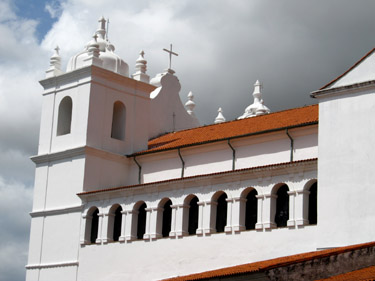

The church of the eleven windows (above) is beautifully maintained
as is the white church across the street and the pink church with
the palms a few
blocks away.


|
|


We saw a few birds in the city parks, but unlike this green heron
and the many black vultures near the waterfront,
most did not sit still for photos.
|
|


The low tide at the waterfront grounded the local boats and
exposed the garbage-laden, stinking mud, but people bustled
about their business anyway.
|
|


|
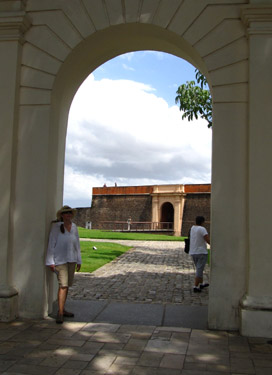
Forte do Presepio is also located in the
waterfront area with its perfectly maintained lawns. Dean made the
mistake of stepping on the grass to look at a sculpture and was
whistled off by a fort guard.
|
|
|
After walking for two and a half hours, we made
our way back to the bus to return to the ship.
As seen from the bus window, it seemed odd to us that a large statue of
liberty reigned over an import shop parking lot outside of the main
city. >>

Back at our pickup spot, the tide was higher and
our ship had swung on its anchor to face toward the mouth of the
river.

|


An active market carried all types of fruits and
grains. The locals were eating at small restaurants with loud
televisions.
|
|
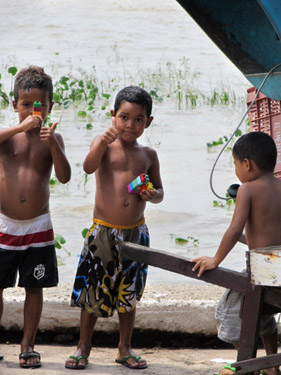

Cute kids with their Lego toys knew to give us a thumbs up for the
photo, while leaf-cutter ants carried the local flora back to their
nests.
|
|

|
You can see a load of lumber behind our ferryboat.
We passed more loads as we rode out to the Amsterdam. We had talked
with a Brazilian working for the cruise ship on the dock. He said most
of this lumber is illegal, but difficult to stop. Kiss the
Amazonian rain forest goodbye one barge load at a time!

|
|
|
As our ferry pulled up to the ship to let us off, we were surprised at the lack of seamanship skills by the ferry driver and also of the receiving crew on the Amsterdam. It must have taken 15 minutes to line up the gate on the ferry with the boarding ramp with a lot of bumping and
lurching. Granted, there was a fair current, but still...

~ ~ ~
Two days at sea and then to Recife (Portuguese for reef and you
pronounce the final e as a long a), the Venice of Brazil, which sits out on the easternmost point of the country. Recife is known for its many rivers and bridges, but unlike Venice,
Italy, the waterways are lined with mangroves. It was first settled by the Portuguese who built up on a hill called Olinda to avoid the swampy lowlands. Then the Dutch with all their lowland experience moved in to develop the waterfront.
We were up for sunrise and were rewarded with a beauty. We watched for the first glimpse of the city. We saw various towns along the way each with a good collection of
skyscrapers. Each time we thought these towns must be Recife. Finally, we arrived at what looked like a huge city and indeed
Recife is a bustling
and interesting place. |
|

|
|

|
We docked at a commercial yard inside a breakwater with a lighthouse
and this cool obelisk. Both tour buses and shuttle busses
awaited our arrival.
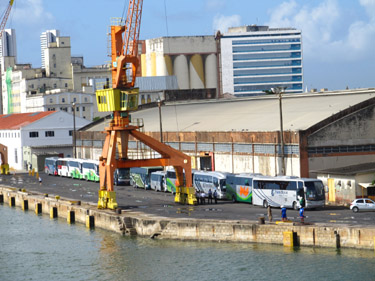
|
|

The view of the waterfront looked enticing from
the top deck of the ship.
|

 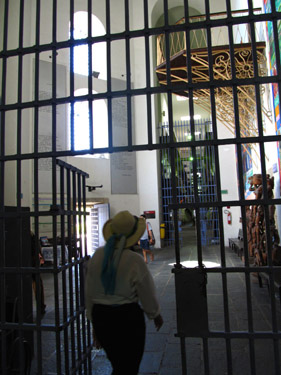
The shuttle to the center of the city took us to a
marketplace that used to be a jail called Casa do Cultura. The vendors displayed their wares in
the jail cells. On the outside of the building, this cool sundial using ceramic faces
and Lucite markers keeps track of the day. |
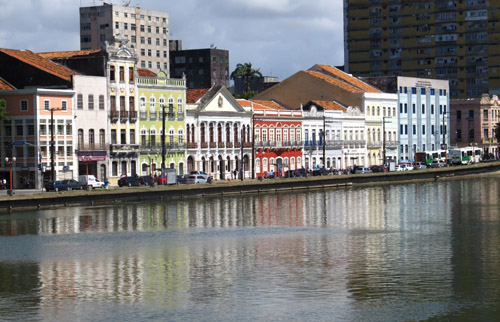
We walked the waterfront areas, bridges, and the central
part of Recife, which show its Dutch origins.
|
|
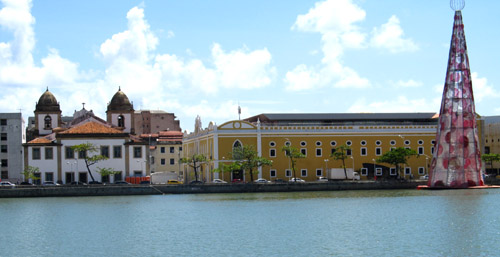
Also in evidence are preparations for Carnaval, (the
celebration before Lent) such as this pink floating tower. We were told
that Recife's celebration is second only to Rio de Janeiro's.
|
|
|
|
|















 We did a lot of walking here. Some
sidewalks were adorned
with sweeping mosaic patterns.
We did a lot of walking here. Some
sidewalks were adorned
with sweeping mosaic patterns. 







































